Kutch embroidery, a celebrated art form originating from the culturally rich region of Kutch in Gujarat, India, is a testament to its artisans’ intricate craftsmanship and vibrant heritage.
Intricate patterns, vibrant threadwork, and signature mirror embellishments characterize this distinctive embroidery style.
The process of creating Kutch embroidery is a meticulous journey that begins with carefully selecting materials and creating intricate designs.
Skilled hands deftly bring these designs to life, employing a range of stitches and techniques. The result is not just a piece of art; it’s a cultural treasure that reflects the rich tapestry of Kutch’s artistic legacy.
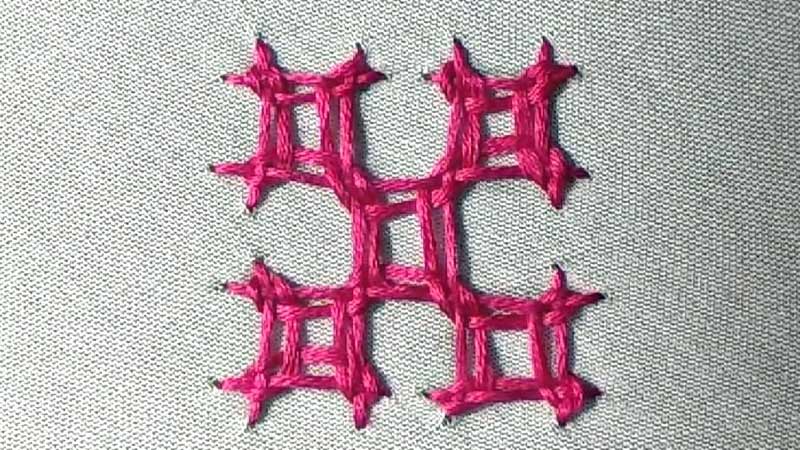
Brief Idea About Kutch Embroidery
Kutch embroidery, originating from the Kutch region in Gujarat, India, is a distinctive form of handcrafted textile art. Renowned for its intricate detailing and vibrant aesthetics, this embroidery style reflects the rich cultural tapestry of its origins.
Key features include geometric patterns, mirror work, and vibrant threadwork, creating a visual symphony of colors and textures.
Artisans employ a variety of stitches, each contributing to the unique texture and design. Mirrors, strategically placed, add a touch of sparkle and charm.
Kutch embroidery finds its way into many products, from garments and accessories to home decor, preserving tradition while captivating admirers worldwide with its timeless beauty and cultural significance.
How Is Kutch Embroidery Made? Detailed Overview
Kutch embroidery, also known as Kachchhi embroidery, is a traditional form of handwork from the Kutch region of Gujarat, India.
It is characterized by its intricate and colorful designs, often featuring geometric patterns, mirror work, and vibrant threadwork.
Here’s a detailed overview of how Kutch embroidery is made:
Materials
- Fabric.
- Threads.
- Mirrors.
- Needles.
Steps in Making Kutch Embroidery:
Design and Pattern Creation

The process of Kutch embroidery commences with the creation of a design. This step is crucial, as it sets the foundation for the entire piece.
Artisans may draw the design on tracing paper or directly onto the fabric using precise pencil strokes or sketch pens.
Traditional Kutch designs are characterized by their geometric precision, often featuring intricate patterns and motifs inspired by nature.
Frame Setting
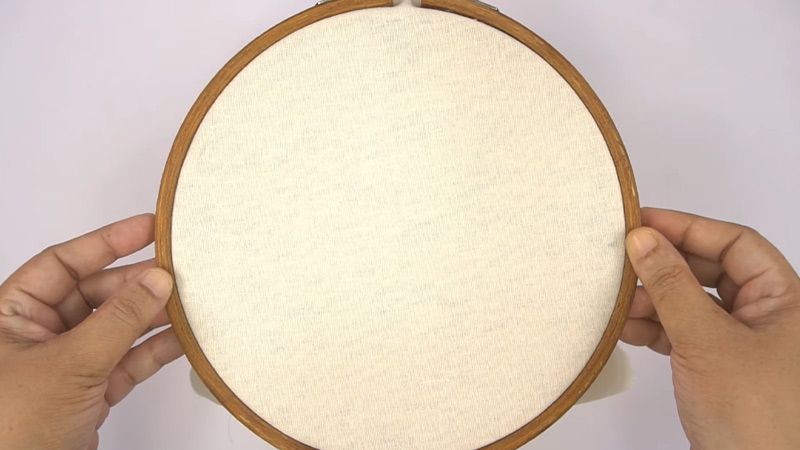
The chosen fabric is carefully stretched and secured over a wooden frame. This meticulous process ensures that the fabric remains taut and even, providing a stable foundation for the embroidery work.
The frame is a stable canvas, making it easier for the artisan to work precisely and accurately.
Outlining
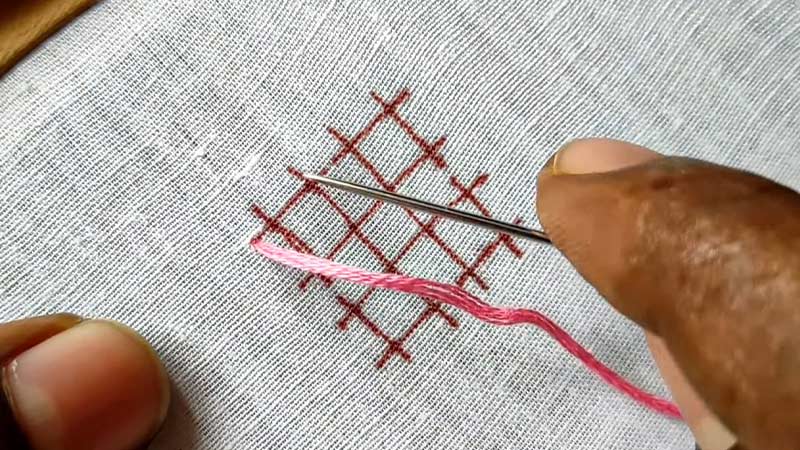
With the fabric securely framed, the artisan begins the embroidery by outlining the design. This initial step involves creating a defined boundary using fundamental stitches such as the running stitch or backstitch.
The outline serves as a guide for the subsequent phases of the embroidery, providing a clear structure for the intricate patterns to follow.
Filling and Detailing
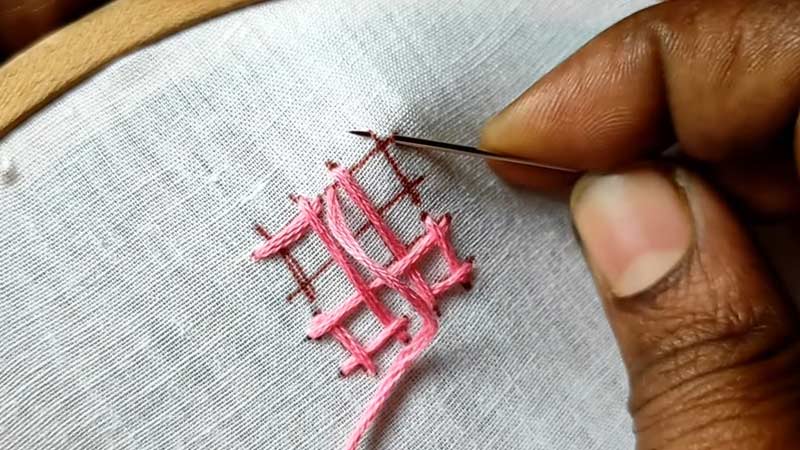
After the outline, the artisan moves on to the filling and detailing phase. This is where the magic truly happens.
Using a variety of stitches, the artisan breathes life into the design. The satin stitch, known for its smooth and even finish, may create a seamless surface.
Chain stitches add texture and definition, while the herringbone stitch might be used for creating intricate patterns.
Mirror Attachment
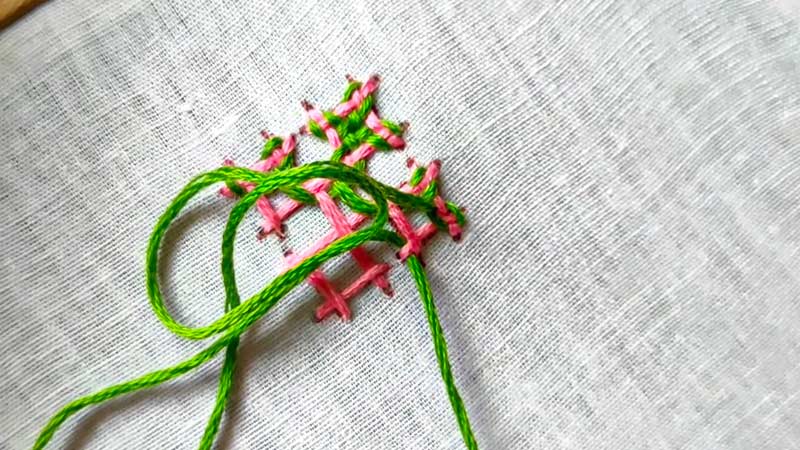
A hallmark of Kutch embroidery is the incorporation of small, reflective mirrors. These mirrors are deftly attached to the fabric, often in geometric patterns or as embellishments within the design.
The artisan meticulously secures each mirror, using a combination of stitches such as the buttonhole stitch, ensuring they remain firmly in place while adding a captivating element of sparkle to the piece.
Additional Embellishments
Beyond mirrors, artisans may introduce additional embellishments to enhance the overall aesthetic.
Beads, sequins, and even small pieces of fabric may be strategically placed to provide a three-dimensional texture and visual appeal.
This stage allows for a creative flourish, adding depth and character to the piece.
Finishing
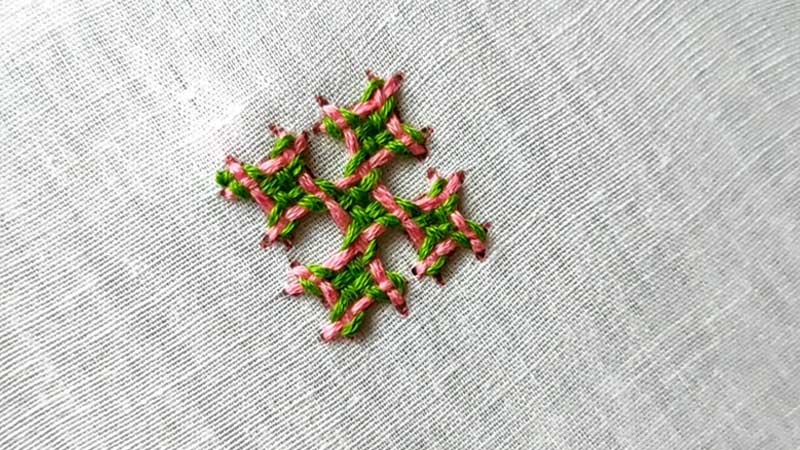
With the embroidery work complete, the artisan meticulously inspects the piece.
Any loose threads or imperfections are carefully addressed, ensuring the final product is of the highest quality. This stage requires a keen eye for detail and a commitment to craftsmanship.
Washing and Ironing
The finished piece undergoes a gentle washing to remove any residual markings or dirt accumulated during the embroidery process.
After careful drying, the fabric is skillfully ironed to smooth out any wrinkles, giving the piece a polished and refined appearance.
Quality Check
Before being deemed complete, the finished embroidery undergoes a thorough quality check.
This step involves meticulously examining every stitch, mirror, and embellishment to ensure that the piece meets the high standards of Kutch embroidery craftsmanship.
Final Presentation
Once the embroidery has passed the quality assessment, it is ready for presentation. The finished piece may be incorporated into various products, including garments, accessories, home decor, etc.
Each Kutch embroidery piece is a testament to the skill, creativity, and dedication of the artisan who has poured their heart and soul into its creation.
Significance and Legacy of Kutch Embroidery
The significance and legacy of Kutch embroidery are deeply intertwined with the cultural and artistic heritage of the Kutch region in Gujarat, India.
This traditional craft holds immense importance for various reasons:
Cultural Identity
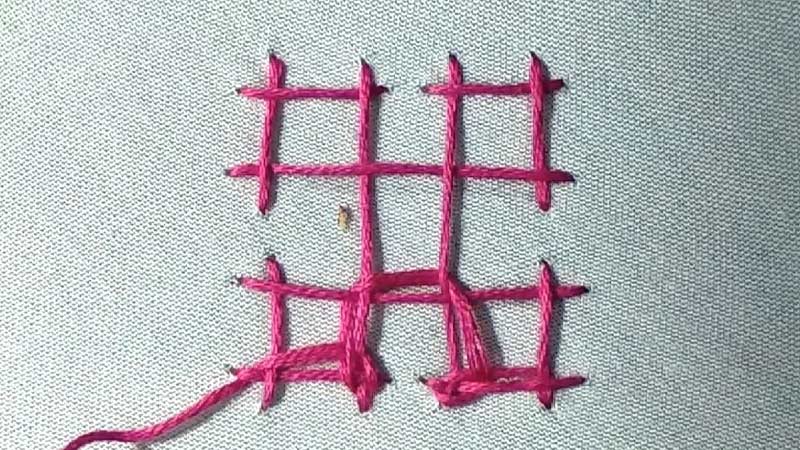
Kutch embroidery symbolizes the rich cultural heritage of the Kutch region. It reflects the history, traditions, and way of life of the communities that have practiced this art for generations.
Each embroidered piece tells a story and carries the essence of the region’s culture.
Economic Empowerment
Kutch embroidery has provided a source of livelihood for countless artisans and their families in the Kutch region.
Artisans can support themselves financially by creating and selling embroidered products and contributing to their communities’ economic development.
Skill Preservation
The art of Kutch embroidery requires intricate skills and techniques that are passed down through generations.
It is a vital means of preserving traditional craftsmanship and ensuring that these skills are not lost to time. Apprenticeships and mentorship play a crucial role in passing on this knowledge.
Creative Expression
Kutch embroidery offers artisans a platform for creative expression. Artisans can infuse their creativity into each piece they create, making each work of embroidery unique.
This allows for the continuous evolution and adaptation of the art form.
Women’s Empowerment
In many Kutchi communities, women are the primary practitioners of embroidery. This craft empowers women by providing them with economic independence and self-expression opportunities.
It has also helped challenge gender norms and promote women’s roles as artisans and entrepreneurs.
Global Recognition
Kutch embroidery has gained recognition and appreciation on a global scale. Its intricate designs, vibrant colors, and reflective mirrors have captured the attention of fashion designers, art enthusiasts, and collectors worldwide.
This global recognition has helped bring economic opportunities to the region.
Popular Products and Uses of Kutch Embroidery
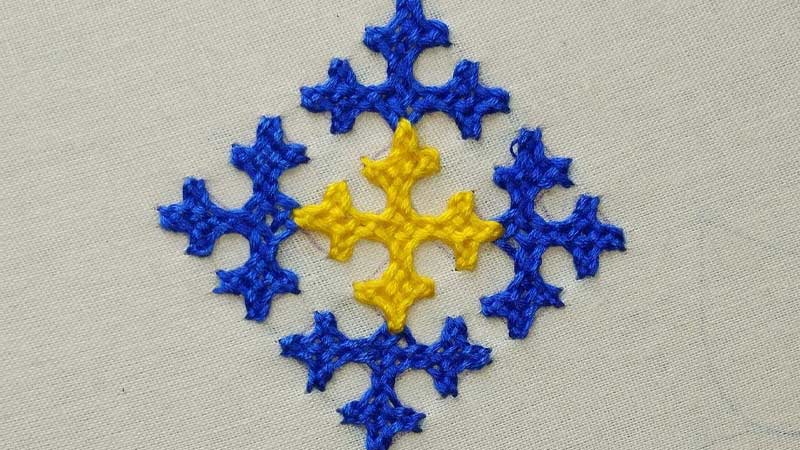
Kutch embroidery, known for its vibrant colors and intricate designs, finds application in various products across fashion, home decor, and accessories.
Here are some of the popular products and uses of Kutch embroidery:
Garments
Kutch embroidery graces various garments with its vibrant and intricate designs. When it comes to blouses, artisans skillfully apply this embroidery to enhance the beauty of traditional Indian attire.
Dresses and Kurtis are adorned with elaborate Kutch work, turning them into wearable art pieces. Lehengas and cholis, particularly in bridal wear, often feature opulent Kutch embroidery, making them exquisite ensembles for special occasions.
Home Decor
In the realm of home decor, Kutch embroidery is a true marvel. Cushion covers are not merely functional but are elevated to pieces of art with the addition of intricate Kutch designs.
Wall hangings serve as captivating focal points in living spaces, showcasing the craftsmanship of the artisans.
Table runners and mats embellished with Kutch work transform dining areas into spaces of elegance and cultural richness. Bedspreads and quilts, with their Kutch embroidery, become cozy sanctuaries adorned with tradition.
Accessories
Kutch embroidery imparts a distinct character to various accessories. Purses, handbags, and clutches become more than just functional items; they are expressions of artistry and heritage.
Footwear, including sandals, is elevated to cultural symbols with the addition of Kutch embroidery, allowing wearers to step out in style while honoring tradition.
Even jewelry pieces, like necklaces and earrings, may feature elements of Kutch embroidery, creating unique and eye-catching adornments.
Potli Bags
Potli bags, known for their elegance and versatility, become true statement pieces with the addition of Kutch embroidery. These drawstring bags, often chosen for special occasions, are elevated to accessories of cultural significance.
They effortlessly combine tradition with contemporary fashion, making them sought-after pieces for those seeking to incorporate heritage into their attire.
Gift Items
Gift items adorned with Kutch embroidery are not just tokens of affection but expressions of artistry and craftsmanship.
Decorative boxes, photo frames, and trinket holders become cherished gifts, bearing the intricate work of skilled artisans. These pieces serve as reminders of the rich cultural heritage associated with Kutch embroidery.
Festive and Cultural Celebrations
Kutch embroidered pieces play a pivotal role in various cultural and festive celebrations. They become symbols of tradition and artistry in weddings, adorning the bridal ensemble with grace and splendor.
During festivals and special occasions, these embroidered pieces become a focal point, captivating observers with their intricate designs and vibrant colors.
Souvenirs and Tourist Crafts
For visitors to the Kutch region, items featuring local embroidery serve as tangible connections to the area’s vibrant culture.
These souvenirs become cherished mementos, allowing travelers to take a piece of Kutch’s rich artistic heritage.
Fashion Accessories
Belts, scarves, and hats adorned with Kutch embroidery add an unmistakable flair to one’s ensemble.
These accessories are more than just fashion statements; they express individual style and an appreciation for intricate craftsmanship.
Maintenance and Care
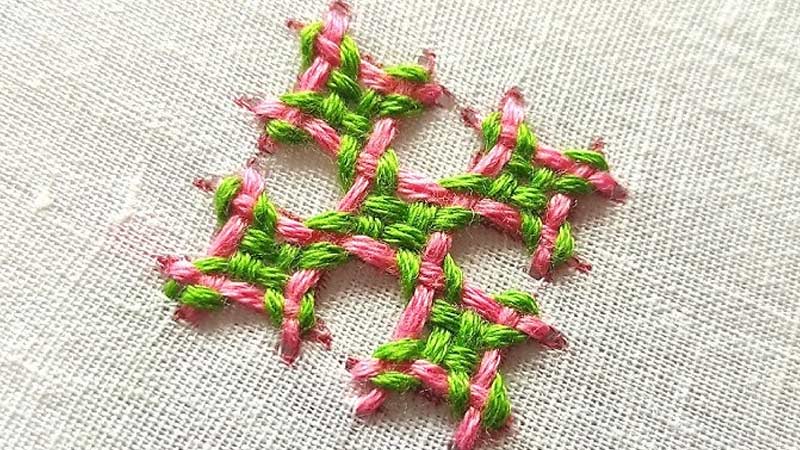
With its vibrant colors and intricate designs, Kutch embroidery is a cherished artistry. Proper maintenance and care are essential to ensure the longevity and beauty of these exquisite pieces.
Here are some valuable tips to help you preserve the intricate craftsmanship of Kutch embroidery:
Gentle Cleaning
If cleaning is necessary, use a soft cloth or a soft-bristle brush to remove dust or dirt gently. Avoid vigorous scrubbing or rubbing, as this can damage the embroidery.
Professional Cleaning
For heavily soiled or stained Kutch embroidered items, consider seeking the services of a professional dry cleaner experienced in handling delicate fabrics and embroidery.
Avoid Harsh Chemicals
Refrain from using harsh chemicals, bleach, or strong detergents on Kutch embroidered items, as they can cause fading, discoloration, or damage to the threads.
Handle Stains with Care
It’s best to seek professional cleaning advice in case of a stain. Avoid removing the stain using home remedies, as this can potentially worsen the situation.
Regular Inspection
Periodically inspect Kutch embroidery for any loose threads, missing mirrors, or signs of damage. Promptly address any issues to prevent further deterioration.
Professional Repairs
For repairs, consult a skilled embroiderer or artisan experienced in Kutch embroidery for professional restoration. Avoid attempting DIY repairs, as they may lead to further damage.
FAQS
What is Kutch embroidery?
Kutch embroidery, also known as Kachchhi embroidery, is a traditional hand embroidery style from the Kutch region of Gujarat, India.
What materials are used in Kutch embroidery?
The primary materials used in Kutch embroidery include fabric (such as cotton, silk, or wool), various threads (cotton, silk, and metallic), small mirrors, and fine needles.
What are the key steps in creating Kutch embroidery?
The process involves design creation, framing the fabric, outlining the design, filling and detailing with different stitches, attaching mirrors, adding embellishments like beads, and finishing with washing, ironing, and quality checks.
What are the popular stitches used in Kutch embroidery?
Common stitches in Kutch embroidery include satin stitch for smooth surfaces, chain stitch for outlines, mirror work stitches, buttonhole stitch for mirror attachment, and herringbone stitch for patterns and texture.
What products can feature Kutch embroidery?
Kutch embroidery can be found on various products, including garments like blouses and dresses, accessories like bags and footwear, home decor items like cushion covers and wall hangings, and cultural items for festive occasions.
To Wrap Up
Kutch embroidery is a testament to the skilled craftsmanship and artistic finesse of the artisans from the Kutch region. The process begins with meticulous design creation, followed by the careful framing of fabric to ensure precision.
Delicate outlining sets the foundation, while various stitches bring intricate patterns to life. Mirrors, a hallmark of Kutch embroidery, add a reflective charm.
Additional embellishments and a final quality check showcase the dedication to perfection. Washing and ironing add the finishing touch, creating vibrant, culturally rich creations.
Kutch embroidery adorns garments and decor and preserves a cherished tradition, echoing the legacy of a centuries-old art form.
Leave a Reply